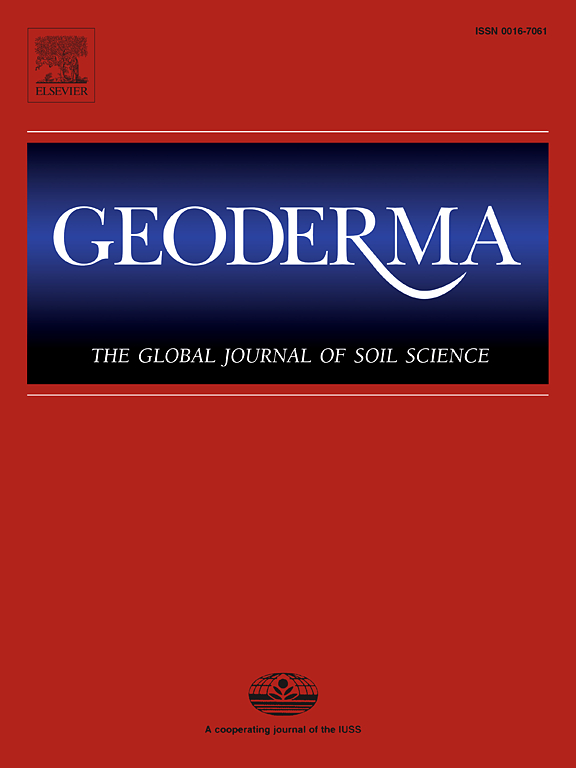A novel method for soil organic carbon prediction using integrated ‘ground-air-space’ multimodal remote sensing data
IF 6.6
1区 农林科学
Q1 SOIL SCIENCE
引用次数: 0
Abstract
High-accuracy maps of soil organic carbon (SOC) content are essential for agricultural management and ecosystem services. However, traditional remote sensing data can hardly balance spatial and spectral resolution, resulting in the inability to simultaneously obtain high-resolution spatial distribution of SOC and detailed spectral features, thus restricting the comprehensive resolution of soil detail information. To address this challenge, we propose an innovative multimodal remote sensing data integration framework, ResoCroS-Net, which integrates ground (soil samples), air (unmanned aerial vehicle (UAV) images), and space (satellite images) data, realized effective integration of multimodal data at different resolutions, with particular innovations in hierarchical design and data-processing logic. Specifically, ground samples and air images are combined to generate high accuracy SOC maps, which serve as the ’spatial’ baseline for ResoCroS-Net used as a reference for subsequent high-resolution image generation. Next, low spatial resolution images (ZY1-02D, Sentinel-2A) are downscaled to high spatial resolution images using Enhanced Super-Resolution Generative Adversarial Network models within adversarial networks. Meanwhile, typical spectral features in ZY1-02D satellite data were extracted, and a spectral dictionary was constructed for accurate reduction of details in low spectral resolution images. Using spectral unmixing networks and sparse representation networks, low spectral resolution images are downscaled to high spectral resolution. Then, joint spatial-spectral features were extracted by 3D convolutional neural network. Based on this framework, we developed Model (i), which integrates SOC data with spatial-spectral resolution downscaling (SSD) image; Model (ii), which integrates SOC data, UAV image with spatial resolution downscaling (SD) image; and Model (iii), which integrates SOC data, UAV image with SSD image. We also evaluated the performance of various algorithms (e.g., Random Forest (RF), Convolutional Neural Networks (CNN), Graph Neural Networks (GNN), and Multi-Layer Perceptron (MLP)) across these models. The SOC prediction experiments conducted in Youyi, the largest state farm in China, demonstrate that Model (iii) achieves the highest accuracy with the GNN model. This model improves coefficient of determination (R2) and ratio of performance to interquartile distance (RPIQ) by 0.09 and 0.28, respectively, and reduces root mean square error (RMSE) by 0.52 g kg−1 compared to Model (ii). In addition, using UAV data as the baseline layer significantly improves prediction accuracy, with R2 and RPIQ increasing by 0.17 and 0.58, respectively, and RMSE decreasing by 1.09g kg−1. Regarding model performance in SOC content prediction, GNN is more suitable for Model (i) and Model (iii), while CNN is more appropriate for Model (ii). In conclusion, ResoCroS-Net achieved collaborative optimization of spatial-spectral features across scales, provided a significant advantage in improving the accuracy of quantitative remote sensing, offers an efficient and accurate SOC monitoring tool, providing a practical basis for the integrated remote sensing theory of ‘ground-air-space’.
基于“地空”多模态遥感数据的土壤有机碳预测新方法
土壤有机碳(SOC)含量的高精度地图对农业管理和生态系统服务至关重要。然而,传统的遥感数据难以平衡空间分辨率和光谱分辨率,导致无法同时获得土壤有机碳的高分辨率空间分布和详细的光谱特征,从而限制了土壤细节信息的综合分辨率。为了应对这一挑战,我们提出了一种创新的多模态遥感数据集成框架——resocross - net,该框架集成了地面(土壤样本)、空中(无人机图像)和空间(卫星图像)数据,实现了不同分辨率下多模态数据的有效集成,特别是在分层设计和数据处理逻辑方面进行了创新。具体来说,地面样本和空中图像相结合,生成高精度的SOC地图,作为resocross - net的“空间”基线,用作后续高分辨率图像生成的参考。接下来,在对抗网络中使用增强型超分辨率生成对抗网络模型,将低空间分辨率图像(ZY1-02D, Sentinel-2A)缩小为高空间分辨率图像。同时,提取ZY1-02D卫星数据的典型光谱特征,构建光谱字典,实现低光谱分辨率图像细节的精确约简。利用光谱解混网络和稀疏表示网络,将低光谱分辨率图像降阶到高光谱分辨率。然后,利用三维卷积神经网络提取关节的空间光谱特征;基于该框架,我们开发了集成SOC数据和空间光谱分辨率降尺度(SSD)图像的模型(i);模型(ii)集成了SOC数据、无人机图像和空间分辨率降尺度(SD)图像;模型(iii)集成了SOC数据、无人机图像和SSD图像。我们还评估了这些模型中的各种算法(例如随机森林(RF)、卷积神经网络(CNN)、图神经网络(GNN)和多层感知器(MLP))的性能。在中国最大的国有农场友谊进行的有机碳预测实验表明,模型(iii)在GNN模型下的预测精度最高。与模型(ii)相比,该模型将决定系数(R2)和性能与四分位数距离之比(RPIQ)分别提高了0.09和0.28,并将均方根误差(RMSE)降低了0.52 g kg - 1。此外,使用无人机数据作为基线层显著提高了预测精度,R2和RPIQ分别提高了0.17和0.58,RMSE降低了1.09g kg−1。从模型在SOC含量预测中的性能来看,GNN更适合模型(i)和模型(iii),而CNN更适合模型(ii)。综上所述,resocross - net实现了空间-光谱特征的跨尺度协同优化,在提高定量遥感精度方面具有显著优势,提供了高效、准确的SOC监测工具,为“地-空-空”一体化遥感理论提供了实践基础。
本文章由计算机程序翻译,如有差异,请以英文原文为准。
求助全文
约1分钟内获得全文
求助全文
来源期刊

Geoderma
农林科学-土壤科学
CiteScore
11.80
自引率
6.60%
发文量
597
审稿时长
58 days
期刊介绍:
Geoderma - the global journal of soil science - welcomes authors, readers and soil research from all parts of the world, encourages worldwide soil studies, and embraces all aspects of soil science and its associated pedagogy. The journal particularly welcomes interdisciplinary work focusing on dynamic soil processes and functions across space and time.
 求助内容:
求助内容: 应助结果提醒方式:
应助结果提醒方式:


